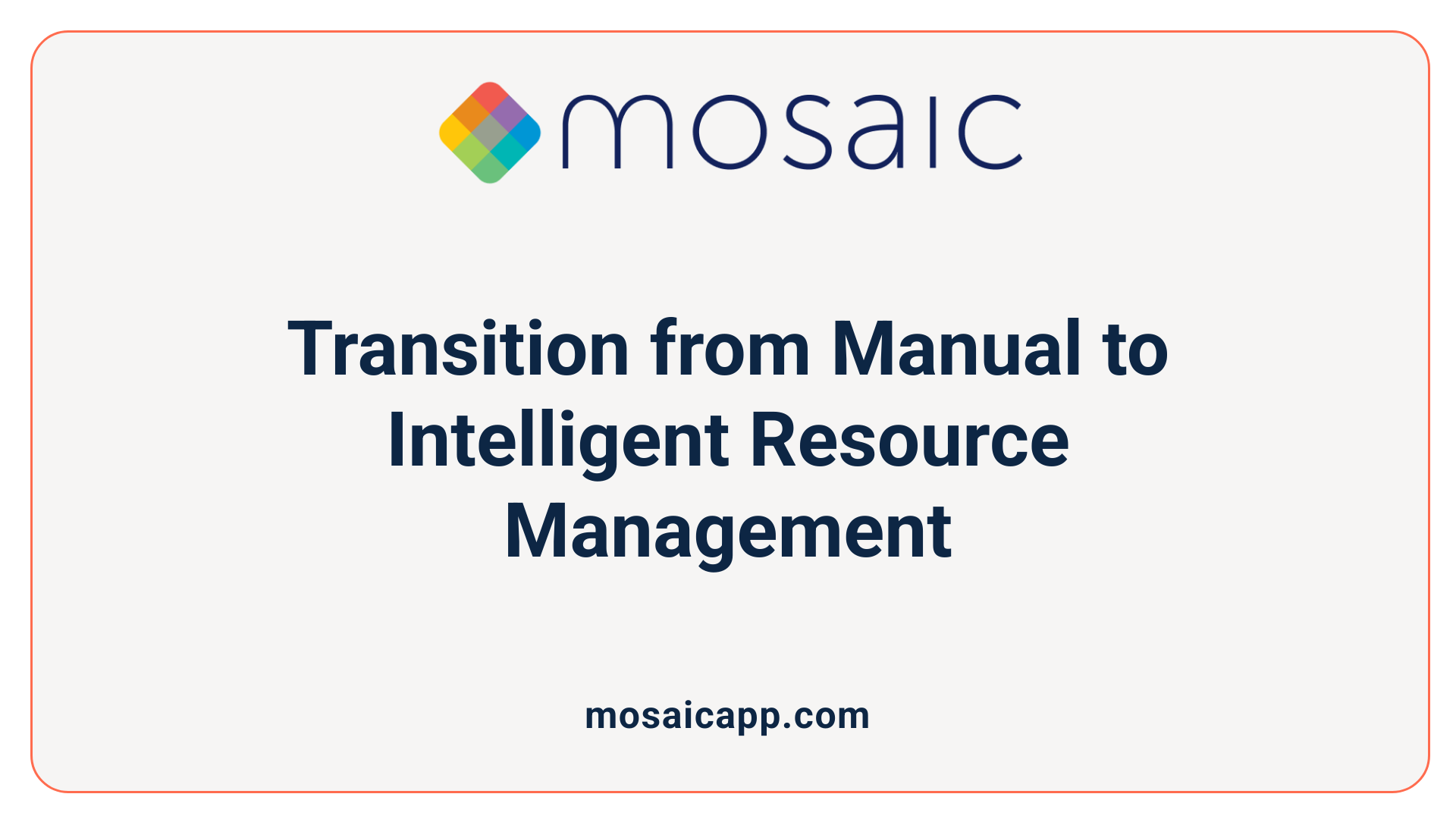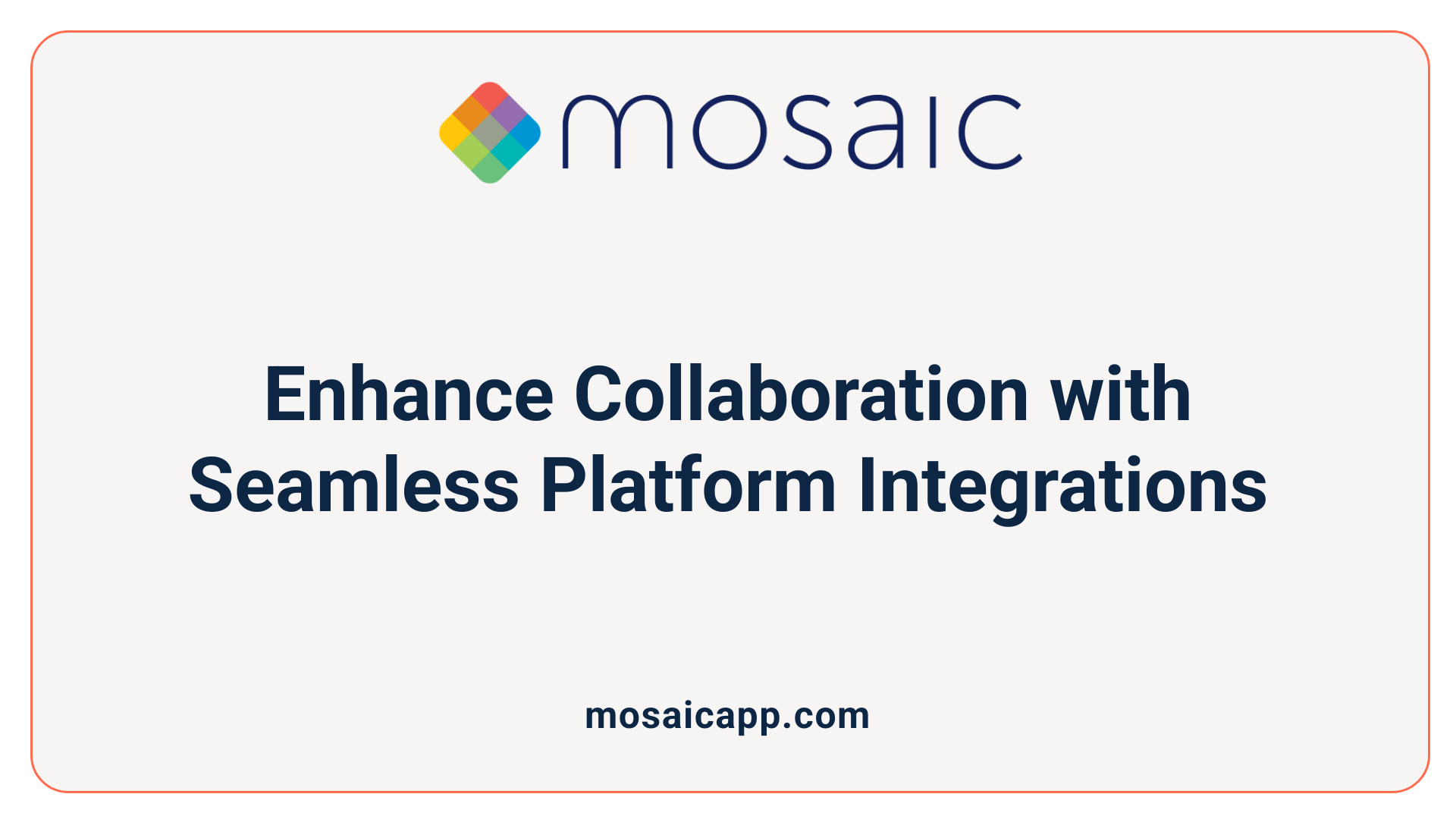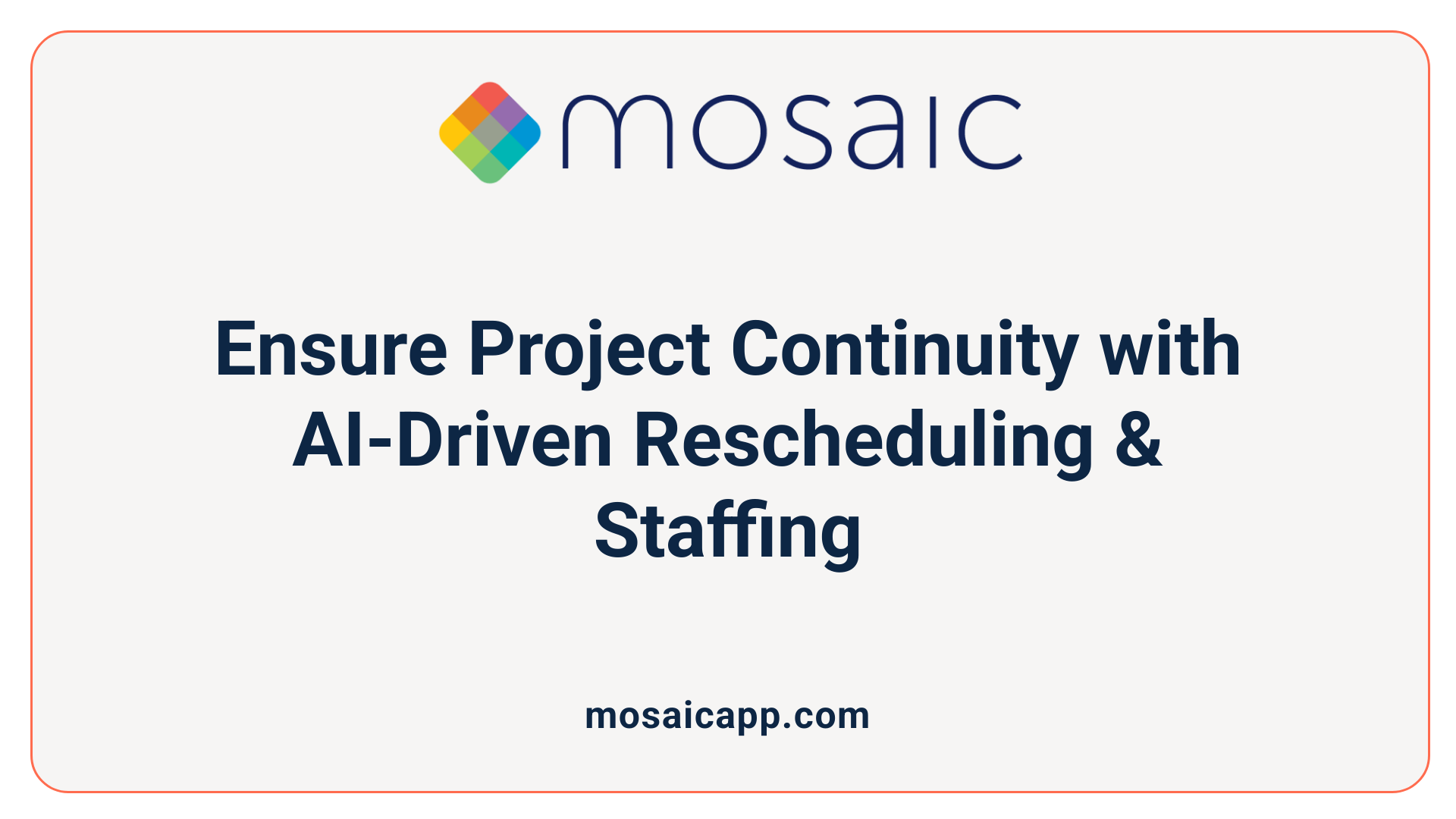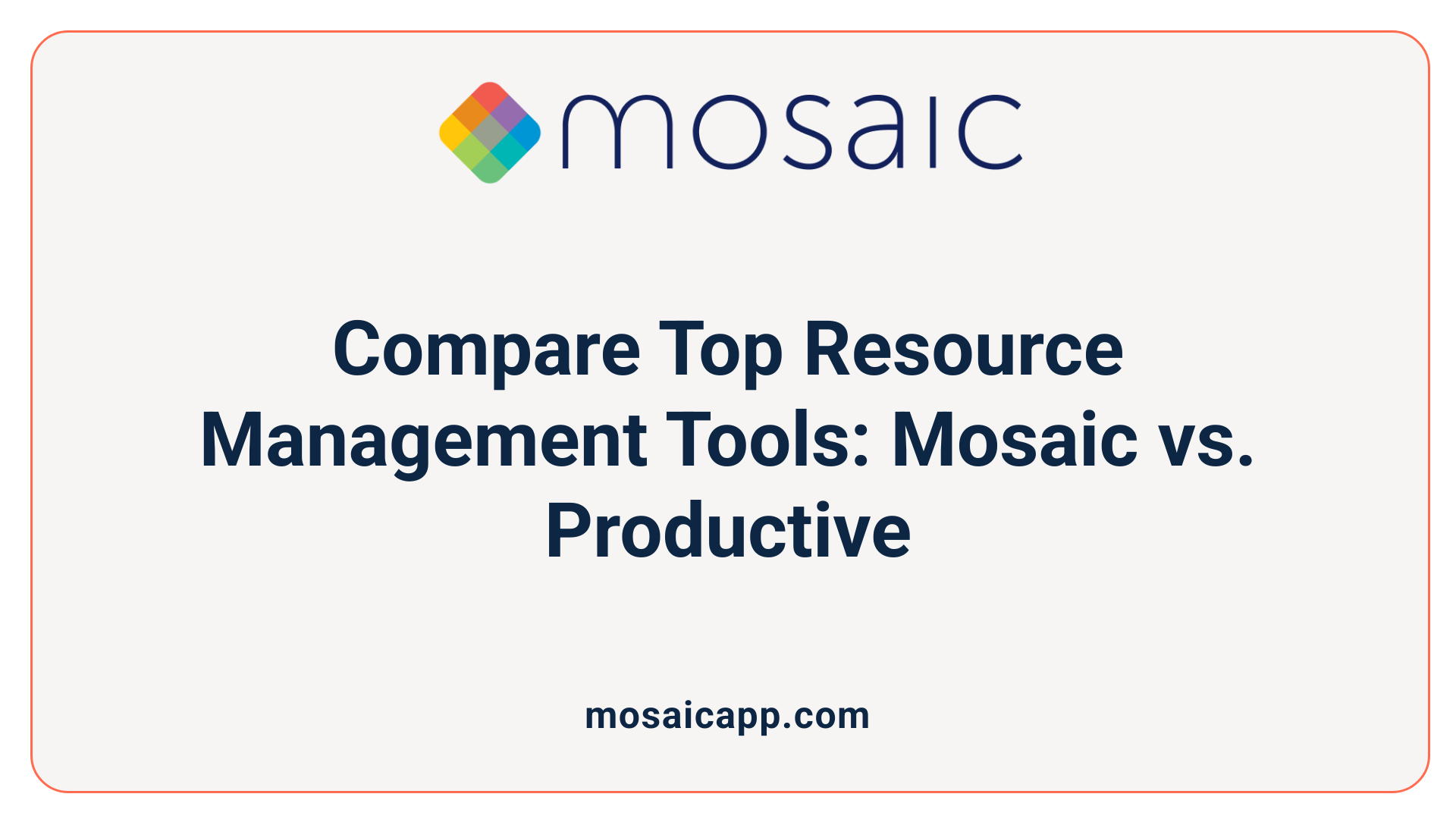Transforming Project Management with AI
In today's dynamic business landscape, traditional tools for project and resource management often fall short in addressing the complexity and agility demands faced by organizations. Mosaic, an AI-driven platform, emerges as a game-changing solution by automating resource allocation, visual planning, and workload forecasting. This article explores how Mosaic delivers superior capabilities beyond legacy tools, enhancing efficiency, financial planning, and team well-being.
From Manual to Intelligent: The Shift in Resource Management

What are the limitations of legacy resource management tools?
Traditional resource management methods often rely heavily on manual input and static scheduling, which can lead to inefficiencies such as underutilized staff, missed deadlines, and cost overruns. These legacy systems typically lack real-time analytics and predictive capabilities, making it harder for organizations to quickly adapt to changing project demands or accurately forecast resource needs.
How does AI improve automation in resource planning?
AI-powered tools like Mosaic transform resource planning by automating key functions. They analyze data in real time—considering factors like team skills, roles, availability, and project deadlines—to generate optimized staffing plans. This automation reduces the administrative burden on managers, helps prevent employee burnout by balancing workloads, and dynamically adjusts schedules when projects experience delays. The use of machine learning further enables accurate forecasting of billing and revenue based on historical and ongoing project data.
What role do integrations with modern platforms play?
Modern AI resource management tools integrate seamlessly with popular project management and collaboration platforms such as Jira, Asana, Trello, and Microsoft Teams. These integrations ensure that resource data remains synchronized across systems, facilitating smooth communication and avoiding duplication of efforts. They also enable the consolidation of project timelines and resource capacity, enhancing visibility and coordination.
How do AI tools streamline processes and reduce inefficiencies?
By automating workflows and providing data-driven insights, AI tools help organizations identify areas of waste and inefficiency. Features like scenario planning allow users to model various outcomes and make informed decisions before committing resources. With real-time analytics and predictive modeling, these tools highlight potential bottlenecks and staffing shortages early enough to take corrective action. Altogether, this leads to optimized resource utilization, cost savings, and improved project success rates.
Comprehensive AI-Driven Forecasting for Strategic Planning
How Does AI Enhance Resource Forecasting in Projects?
AI tools like Mosaic and Productive employ advanced resource forecasting to analyze past and current data, such as team skills, roles, availability, and workloads. This allows them to predict future resource utilization accurately and suggest optimal staffing plans. Mosaic, for instance, uses machine learning to forecast billing and revenue by processing project plans, timesheets, and budgets. Productive’s forecasting module also enables organizations to anticipate employee utilization and financial performance effectively.
What Role Does Dynamic Scheduling Play in Project Success?
Dynamic scheduling capabilities in AI platforms automatically adjust project plans in response to delays or new developments. Mosaic, for example, features automatic rescheduling that realigns tasks and resources to get projects back on track without manual intervention. This ensures real-time optimization of workloads and helps prevent burnout by balancing team member assignments dynamically.
How Does Predictive Modeling Support Project Management?
Predictive modeling in AI-driven resource management equips organizations to anticipate potential risks and forecast financial outcomes. Tools like Productive incorporate scenario planning features to model different future possibilities, facilitating informed decision-making. Mosaic analyzes historical project profitability patterns to identify the most lucrative types of projects and provides insights to guide future proposals.
What Benefits Do Real-Time Analytics and Customizable Reporting Provide?
Real-time analytics offer up-to-date insights into project status, resource utilization, and financial metrics, enabling proactive adjustments to improve performance. Customizable reporting allows stakeholders to tailor information to specific needs, making communication and oversight more efficient. Both Mosaic and Productive offer these features, enhancing transparency and control over project portfolios.
How Do These Features Improve Overall Decision-Making?
By integrating resource forecasting, dynamic scheduling, predictive modeling, analytics, and reporting, AI-driven tools facilitate data-driven decision-making. Organizations can optimize resource allocation, anticipate bottlenecks, manage financial risks, and improve operational efficiency. This comprehensive approach supports cost reduction, increases profitability, and promotes successful project delivery.
Seamless Integration: Enhancing Workflow with Popular Platforms

How Does Mosaic Integrate with Popular Platforms?
Mosaic is designed to fit smoothly into existing work environments by offering seamless integrations with widely used platforms like Jira, Asana, Trello, and Microsoft Teams. These integrations enable teams to connect their project management and communication tools directly with Mosaic's AI-powered resource management and forecasting capabilities.
How Do These Integrations Enhance Collaboration?
By linking Mosaic with familiar platforms, teams can enhance collaboration across departments. For example, updates made in Jira or Trello automatically reflect in Mosaic, ensuring that resource plans and workload forecasts remain accurate and up to date. This interconnectedness reduces manual entry and miscommunication, streamlining coordination between project managers and team members.
What Role Does Data Centralization Play?
Integrations centralize data from multiple sources within one system. This consolidation allows Mosaic's AI algorithms to analyze comprehensive information such as team skills, deadlines, budgets, and historical project data. Centralized data fosters smarter decision-making, as all relevant information is accessible in one place, reducing the risk of overlooked details and promoting transparency.
How Does Mosaic Support Existing Workflows?
By working alongside popular tools, Mosaic supports rather than disrupts established workflows. Teams don't need to abandon familiar systems; instead, they benefit from enhanced resource optimization and workload forecasting capabilities integrated seamlessly into their daily routines. This makes adoption easier and improves overall productivity with minimal friction.
Optimizing Utilization and Preventing Burnout through AI Insight
How does Mosaic analyze team skills, roles, and deadlines?
Mosaic leverages AI to deeply analyze various data points including team members' skills, their specific roles on projects, and critical deadlines. By continuously reviewing these variables, it gains a clear understanding of each individual's capabilities and availability, which helps in making informed resource management decisions.
What AI recommendations does Mosaic provide for team assignments?
The AI-driven system suggests optimal project assignments for team members by matching their skills and availability to the demands of upcoming projects. This approach avoids overburdening individuals and ensures the right people are allocated to the right tasks, maximizing efficiency.
How does using Mosaic increase utilization rates?
By intelligently balancing workloads and assigning tasks based on data, Mosaic increases team utilization. It prevents idle time and reduces bottlenecks, ensuring resources are consistently engaged without becoming overwhelmed. This balanced distribution supports higher overall productivity.
How does Mosaic support employee well-being and workload balance?
Mosaic actively helps prevent burnout by monitoring workload in relation to capacity. The software provides alerts and suggestions for hiring or rescheduling when workload exceeds sustainable levels. This feature promotes a healthier work environment by ensuring employees maintain a manageable pace and avoid excessive long hours.
In summary, Mosaic's AI capabilities not only optimize resource utilization but also foster employee well-being by creating well-balanced workloads and preventing burnout through smart, data-driven planning.
Adaptive Rescheduling and Staffing Suggestions for Project Continuity

How Does Automatic Rescheduling Work to Adjust for Project Delays?
Mosaic utilizes AI-powered automatic rescheduling to dynamically adjust project plans when delays occur. This feature continuously monitors project progress and timelines. When a delay is detected, the system recalibrates the schedule to accommodate new deadlines and resource availability without manual intervention. This helps prevent bottlenecks and maintains workflow continuity.
In What Ways Does AI Recommend Staffing to Support Project Success?
The AI in Mosaic analyzes historical project data, team member skills, roles, and current workloads to make intelligent staffing suggestions. It recommends the best-suited employees for upcoming projects by considering their availability and efficiency patterns. This process not only increases team utilization but also prevents burnout by distributing workloads evenly.
How Does Capacity Analysis Inform Predictive Hiring Suggestions?
Mosaic performs thorough capacity analysis by comparing current and forecasted workloads against available resources. If the tool identifies that workloads exceed current staffing capacity, it proactively alerts the organization to potential staffing needs. These predictive hiring suggestions enable organizations to onboard the necessary talent in advance, ensuring projects stay on track.
By combining automatic rescheduling with data-driven staffing recommendations and predictive hiring insights, Mosaic helps organizations maintain project continuity while optimizing resource use. This AI-driven approach supports timely decision-making, reduces operational risk, and ultimately enhances overall project success.
Financial Intelligence: Profitability Insights and Revenue Forecasting

How does profit and loss analysis work in AI-driven tools like Mosaic?
Mosaic uses historical project data to identify profit and loss sectors, highlighting which types of projects deliver the best financial returns. By analyzing past project outcomes, Mosaic reveals patterns that help organizations understand where profits come from and where losses are likely. This insight guides future project proposals, allowing firms to focus resources on high-value activities and reduce financial risk.
In what ways is historical data utilized for financial forecasting?
Historical data serves as the foundation for both profitability analysis and revenue forecasting. Mosaic leverages data such as project scope, budgets, timesheets, and past billing records to create models of financial performance. This thorough examination of past performance enables the AI to generate accurate forecasts, detecting trends and financial patterns that inform decision-making.
How does billing and revenue prediction benefit from machine learning?
Machine learning algorithms within Mosaic analyze diverse datasets including project timelines, budgeting, and resource allocation to predict future billing and revenue. This continuous learning from evolving data improves the accuracy of predictions over time, helping organizations anticipate cash flow, schedule billing cycles effectively, and align staffing with revenue goals.
What roles do machine learning applications play in project financial forecasting?
Machine learning powers Mosaic's ability to forecast financial outcomes by processing vast amounts of data to identify correlations between project activities and financial metrics. It adapts dynamically to changes such as project delays or shifts in team availability, automatically adjusting forecasts and suggesting corrective actions like staff reallocation or project reprioritization to optimize financial performance.
Why is project financial forecasting important for organizations?
Effective forecasting allows organizations to anticipate financial results, manage budgets proactively, and improve profitability. By integrating AI-driven forecasting tools like Mosaic, professional services firms gain a strategic advantage, combining resource planning and financial intelligence to make informed decisions that enhance operational efficiency and promote sustainable growth.
Supporting Professional Services with Specialized Tools: Mosaic vs. Productive

How do Mosaic and Productive compare in their capabilities?
Mosaic and Productive both cater to professional services organizations, yet they focus on different aspects of resource management and financial planning. Mosaic excels with AI-driven resource management features such as automated staffing recommendations, dynamic rescheduling, and skill-based workload balancing. It integrates well with popular project tools like Jira and Trello. Productive offers a broad platform combining integrated resource planning, budgeting, billing, and project management, making it particularly comprehensive for managing organizational profitability and operational efficiency.
What resource planning, forecasting, and budgeting features do they offer?
Both tools provide robust resource forecasting to enhance project and employee planning. Mosaic uses AI to analyze team skills, roles, and deadlines for optimized project assignments while predicting billing and revenue through machine learning models. Productive’s forecasting module supports employee utilization and financial performance projections, aligning resource scheduling with budgets.
Does scenario planning play a role?
Productive includes scenario planning features that allow users to model various future project and financial outcomes, helping make informed decisions to mitigate risks. Mosaic, while concentrating more on AI automation and dynamic scheduling, complements this by enabling quick adjustments based on real-time project changes.
How do they manage financial performance?
Mosaic Tech stands out in strategic financial management by delivering financial reporting, revenue planning, and forecast models that assist in identifying profitable projects and improving billing accuracy. Productive also supports visualization, reporting, and automation tools to track and improve financial performance aligned with resource planning.
Together, these platforms provide professional services organizations with complementary tools for optimizing both resource allocation and financial health, enabling smarter project execution and strategic decision-making.
Operational Efficiency and Cost Reduction Through AI Automation
How Does AI Automation Minimize Waste and Inefficiencies?
AI tools like Mosaic leverage automation to streamline workflows by analyzing vast amounts of project and resource data. This enables automated rescheduling, workload forecasting, and optimized resource allocation to prevent overstaffing or underutilization. By continuously adjusting plans based on real-time inputs, these tools reduce idle times and eliminate redundant tasks, minimizing waste effectively.
What Role Does Cost Control Play in AI-Driven Resource Management?
AI-powered software assists organizations in keeping costs in check by accurately forecasting billing, revenue, and employee utilization. Mosaic, for example, uses machine learning to predict financial outcomes from project data, timesheets, and budgets. Early alerts about staffing needs and profit-loss insights allow managers to avoid costly bottlenecks or unprofitable projects.
How Does Automation Impact Operational Workflows?
Automation transforms operational workflows by replacing manual scheduling and resource tracking with AI-driven recommendations. Mosaic’s automatic rescheduling feature helps adjust project plans in response to delays while maintaining realistic deadlines. This agility uplifts project continuity and reduces stress on teams by preventing burnout through smart task assignments.
In What Ways Does AI Boost Profitability?
By enhancing resource utilization and financial forecasting, AI tools contribute directly to higher profit margins. They help identify the most profitable project types through historical analysis and streamline staffing to fit demand without overspending. Integration with existing financial software like QuickBooks further ensures seamless budget adherence, paving the way for sustained profitability.
Integrating Financial Tools and Enhancing Organizational Decision-Making
How Does Mosaic Integrate With Financial Software Like QuickBooks and Deltek?
Mosaic streamlines resource and project management by supporting seamless integration with popular financial tools such as QuickBooks and Deltek. This compatibility enables organizations to synchronize financial data effortlessly across platforms, ensuring that budgeting, billing, and forecasting remain aligned with real-time project operations. By bridging operational workflows with accounting systems, Mosaic eliminates manual data entry and reduces errors, facilitating smoother financial management.
What Comprehensive Financial Reporting Does Mosaic Provide?
Mosaic offers extensive financial reporting features that deliver insights into revenue planning, billing forecasts, profit and loss sectors, and project financial performance. Its AI-driven analytics delve into project data, timesheets, and budgets to generate accurate forecasts and identify profitable opportunities. Customizable reports allow firms to tailor financial data presentation according to different stakeholders’ needs, supporting transparency and informed decision-making.
In What Ways Does Mosaic Support Strategic Financial Management?
By combining AI-powered forecasting and scenario planning, Mosaic supports strategic financial management through predictive modeling and resource optimization. Its ability to analyze past project performance and team capabilities enables the software to recommend staffing and scheduling adjustments proactively. These insights help organizations anticipate financial trends, manage risks effectively, and make informed decisions to improve profitability and operational efficiency.
How Is Customer Support Delivered by Mosaic?
Mosaic Tech is recognized for its responsive and user-friendly customer support, helping organizations maximize the platform's benefits. The support team assists with onboarding, troubleshooting, and customized use cases, ensuring that clients can rely on expert advice when optimizing their resource and financial management processes.
Together, these capabilities make Mosaic a valuable tool for organizations aiming to integrate operational and financial data seamlessly, enhance forecasting accuracy, and strengthen strategic financial planning.
Embracing the Future of Resource Management with Mosaic
As project management demands escalate in complexity, Mosaic stands out as a robust AI-driven platform that surpasses legacy tools by combining automation, predictive analytics, and seamless integration. Its ability to optimize resource utilization, forecast financial outcomes, adapt dynamically to project changes, and support strategic decision-making positions it as an essential asset for organizations striving for operational excellence and sustainable growth. Adopting Mosaic is not just upgrading software — it is embracing a transformative approach that empowers teams and drives profitability in ways legacy tools simply cannot match.


